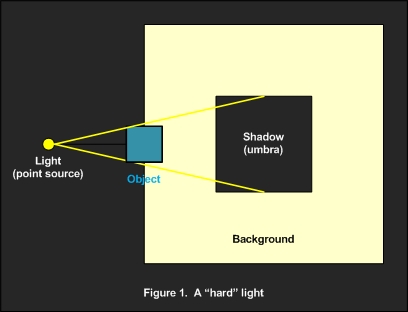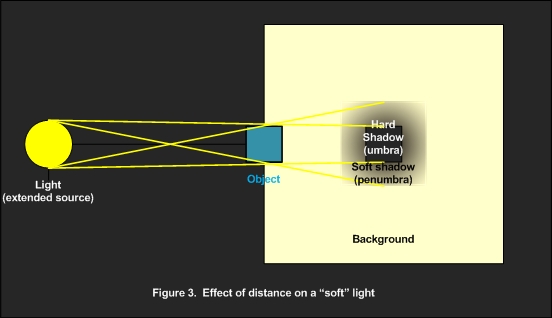
 |
|
Commercial Photography · Aerial Photography · Studio Rental · Classes |
One thing you frequently read or hear about with photography is the quality of lighting as either "hard" or "soft." Many beginners mistakenly thing this refers to how bright a light is, or the ratio between the key and fill lights, but those aren't it at all. What makes a light hard or soft is it's apparent size relative to the subject. In actual fact, it's not a quality of the light, but rather a quality of the shadow.

Look at figure 1. It diagrams a light and the shadow cast by an object on a background. In this case the light is a "point source." That is, it's very small (in size, not brightness), like you might get from an unmodified on-camera flash. In this simple case, the background is either lit by the flash, or it is shadowed by the object. Light always travels in a straight line (we're ignoring relativity and quantum effects here!), and since the light source is a single point, all the light rays come from that single point source. The rays that hit the edge of the object are shown in yellow, and these define where the shadow is. This type of shadow, where the light source is completely hidden is called an "umbra" (from the Latin for "shadow").

Figure 2 shows what happens if the light source is bigger than just a single point. This can be accomplished by a reflector such as an umbrella or a diffuser (usually coupled with a reflector) such as a soft box. In this situation, things are not quite so simple. There are still areas of the background lit fully by the light source, and there is an umbra shadow where the light source is completely hidden, but notice now that it's much smaller. That's because the bigger light source can "peek around the edge" of the object. In fact there's now an area of "soft" shadow, or penumbra (from the Latin for "almost shadow") which is even larger than the shadow from the point source. This area is where some, but not all, of the light source is hidden by the object. Unlike the umbra, which is uniformly dark, the penumbra is not uniform. The area of the penumbra close to the center is darker shadow because very little of the light source is visible (most is hidden by the object). Out towards the edges of the penumbra, the shadow is much lighter, because it is illuminated by most of the light source (just a little is hidden by the object).

Figure 3 shows what happens if you move the light further away. The light and object are the same size as in Figure 2, and the object is the same distance from the background, but now the light has been moved away from the object (and background). Notice now that the umbra is larger than in Figure 2, and penumbra is smaller. That is, the light has gotten "harder." Why is this? The light is the same size, but since it is further away from the object it appears smaller to the object because of perspective. It's apparent size is smaller, more like a point source, and thus harder.
This means that you can control the hardness or softness of your light by how you position it as well as how you modify the source with a reflector or diffuser. Of course, another way of saying that is that moving your light may have the (un)desired efffect of changing it's hardness/softness. This is particularly important if you are shooting with "hot lights," which, in general, cannot be dimmed. The only way to change their brightness is to change bulbs or move the light. With strobes, most of which can be dimmed over a a fairly wide range, you have the choice of dimmming the strobe (keeping the hardness the same) or moving the light (changing the hardness).
I should mention here that I said that the ratio of key light to fill light was not related to hardness/softness. While that's technically true, the combination of key and fill lights can "soften" an otherwise "hard" scene. Since the fill light will partially light the background even where it's shadowed from the key light, this will make the shadow less noticable. It's not truly softer, as there's no gradation of the shadow from umbra to lit, it's just that the umbra is not as deep. The brighter the fill (or background) light, the more it will "wash out" the key shadow. Of course this runs the risk of "flattening" your image, since the difference between key and fill is what provides depth to the image, but these sorts of tradeoffs are what make lighting fun!
Whether you want a hard light or a soft light depends on the effect you are going for. A hard light gives a harsh sharp-edged characteristic to the image. A softer light makes things smoother and more subtly shadowed. Generally for portrait work you want a soft light, which is why most portrait photographers use umbrellas and/or soft boxes. You'll have to decide for yourself what type of light you want for a given image, but at least understanding what makes a light hard or soft, and how you can modify it, will allow you to control the light. And let's face it, controlling the light is what photography is all about!
Good luck and happy shooting!
Back to The Photographer's Journal
| ©2008 ArtSmith Photography, all rights reserved. | Home • Portfolio • About ASP • Capabilities • Pricing • Contact • Journal |